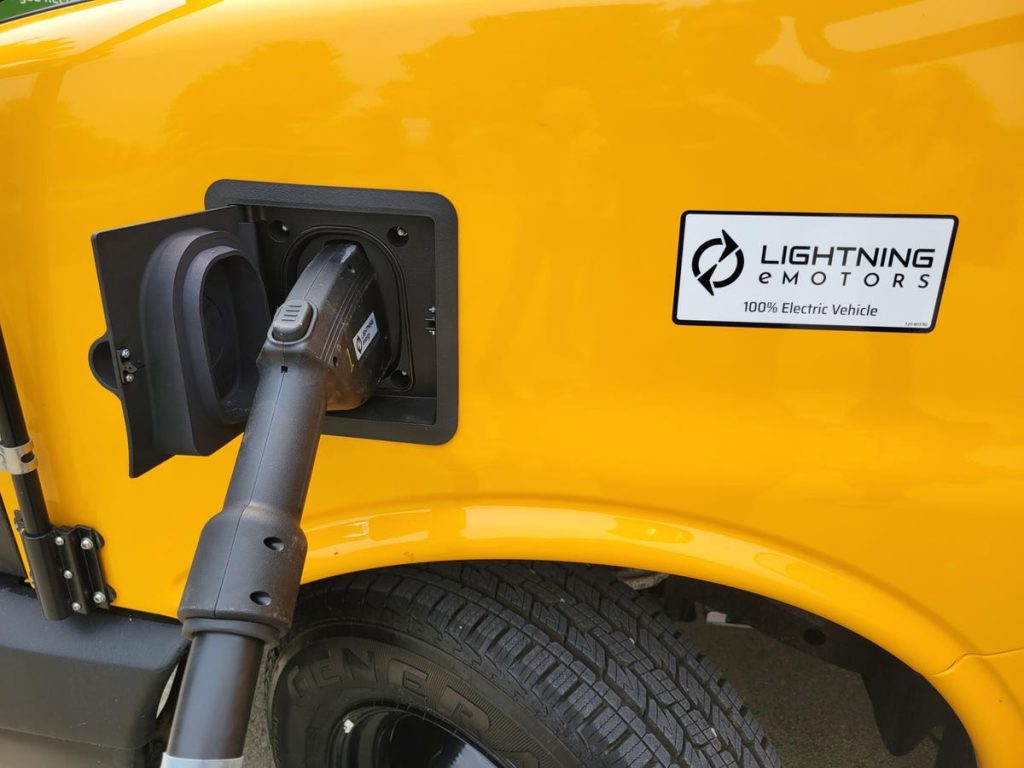On a hazy morning on an island in the middle of the Detroit River a reporter sat behind the wheel of a battery electric vehicle, hit the accelerator pedal and promptly powered through a slalom course screeching the tires and thrilling the half-dozen or so passengers.
Not bad for a school bus and definitely not your parents’ student hauler. It’s the ZEV 4, Type A school bus—a product of a partnership between Loveland, Colo.-based Lightning eMotors and Collins Bus Corporation on a GMC Savana 4500 / Chevrolet Express 4500 platform.
It’s a smaller sized school bus but for Lightning eMotors, which integrates its battery electric powertrain into the buses, the yellow coach represents a major play in a segment that includes a half-million school buses of all types on the road today.
Indeed, “it’s our our fastest growing segment,” said Lightning eMotors CEO and co-founder Tim Reeser in an interview Tuesday during a media program on Detroit’s Belle Isle park. The company also electrifies commercial vans based on the Ford Transit van but the school bus now represents 80% of its business, according to Reeser.
Lightning eMotors also electrifies commercial vans built on the Ford Transit chassis and produces mobile recharging stations that can be bought or rented.
While he expects to have about 100 ZEV 4 school buses on the road this year in 20 school districts Reeser believes those numbers will quickly grow.
At face value, however, the cost for each bus might appear to be prohibitive for budget-minded school districts. Reeser explained the buses are sold through a multistage process where Collins sells it to a bus dealer who then sells it to a school district at a cost of about $220,000 each.
That’s a big sticker, but Reeser says the crazy quilt of government incentives and credits mitigate what might otherwise be a budget-breaker for school districts, contributing to the fast growth in sales for his company.
“Right now, because the EPA came out with a $5 billion subsidy for electric school buses last year, and so they’ve been doling out a billion a year. But on top of the EPA money you can also get the new inflation Reduction Act money pays the schools $40,000 per vehicle for these as well for sure,” said Reeser. “Then there are also some state programs—Colorado, California have state programs. So a lot of, you know, nearly $10 billion in total of money out there for school buses, for electric school buses.”
Of course, all that government money won’t always be available. At some point it’s likely to disappear eliminating both financial incentives and relief for would-be customers. But Reeser is not only optimistic, but outwardly certain if the temporary cash carrot is removed, his company won’t be stuck without customers willing to pay the full freight.
For one, he contends the higher sales volumes spurred on by government incentives will result in lowering the costs to produce and distribute the electric school buses.
Reeser also characterizes the EV ecosystem, which includes charging and servicing, is becoming more mature elaborating, “we’re getting better at it, the customers are getting better. So that’s allowing the customers to say, hey, even when the grants are gone, still, it’s 80% less to run this bus versus a gasoline bus. So as long as you can get the cost down to where that makes sense and the financing in place, we don’t need grants anymore. That equation works even today, but as we get more volume, it becomes even more compelling. So these will be on a total cost of ownership basis significantly cheaper than gasoline in the next two or three years.”
That’s more than a half-full outlook on how things might play out, and one industry observer who attended Tuesday’s program believes any risk Lightning eMotors is taking by banking so much of its future on the existence of government givebacks is worth taking.
“There is risk there with incentives,” said Edgar Faler, Managing Director, Financial Analytics and Industry Strategy, Center for Automotive Research. “I think that’s more of a legislative political subject to some of the political climates and how some of these things might get modified in the future, but you got to take it while it’s there.”
From Reeser’s standpoint it’s not only there, it’s there for the taking, and Lightning eMotors is taking its electric school bus to get there, declaring,“So, right time, right place. This is where we’re focused. That’s why we see our success.”
Read the full article here






